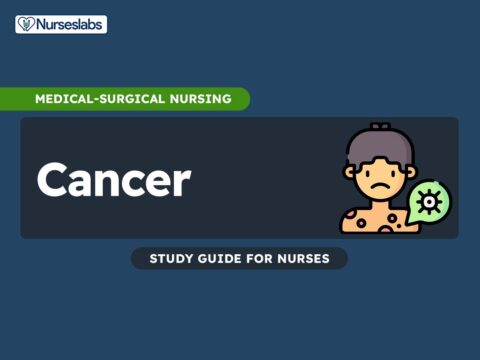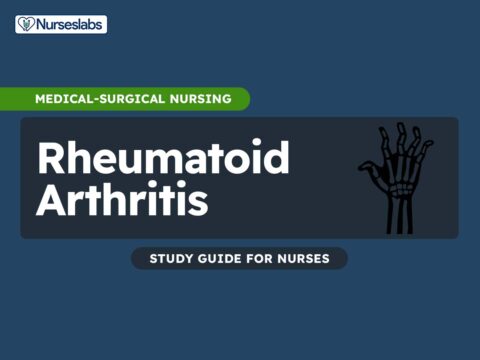Learn about the nursing care management of patients with bronchiectasis in this study guide.
What is Bronchiectasis?
Chronic pulmonary disorders are the leading cause of morbidity and mortality in the United States.
- Bronchiectasis is a chronic, irreversible dilation of the bronchi and the bronchioles.
- Under the new definition of COPD, it is considered a disease process separate from COPD.
Pathophysiology
Bronchiectasis is usually localized, affecting a segment or lobe of a lung, most frequently the lower lobes.
- Inflammation. The inflammatory process associated with pulmonary infection damages the bronchial wall, causing a loss of its supporting structure and resulting in thick sputum that ultimately obstructs the bronchi.
- Distention. The walls become permanently distended and distorted, impairing mucociliary clearance.
- Collapse. The retention of secretions and subsequent obstruction ultimately cause the alveoli distal to the obstruction collapse.
- Scarring. Inflammatory scarring or fibrosis replaces functioning lung tissue.
- Symptoms. In time, the patient develops respiratory insufficiency with reduced vital capacity, decreased ventilation, and an increased ratio of residual volume to total lung capacity.
- Impairment. There is impairment in the match of ventilation to perfusion and hypoxemia.
Causes
Bronchiectasis may be caused by a variety of conditions including:
- Airway obstruction. Obstructions in the bronchi distend the wall permanently and impair mucociliary action.
- Pulmonary infection. Pulmonary infection and obstruction of the bronchus or complications of long-term pulmonary infections cause bronchiectasis.
- Genetic disorders. Genetic disorders such as cystic fibrosis causes the sputum to thicken in consistency and would ultimately obstruct the bronchi.
- Idiopathic causes. There are causes that are unknown to medicine that cause bronchiectasis.
Clinical Manifestations
Characteristic symptoms of bronchiectasis include:
- Chronic cough. Cough that has been going on for two (2) months or more may be indicative of bronchiectasis.
- Purulent sputum. Production of purulent sputum in copious amounts is present.
- Hemoptysis. Many patients with this disease have hemoptysis.
- Clubbing of the fingers. Clubbing of the fingers is also a common symptom because of respiratory insufficiency.
- Recurrent infection. Patients have repeated episodes of pulmonary infection.
Complications
Potential complications include:
- Atelectasis. Collapse of the alveoli is a common complication.
- Pneumonia. Infection is recurrent in patients with bronchiectasis.
- Empyema. Overproduction of sputum causes the bronchi to be filled with pus.
Assessment and Diagnostic Findings
Bronchiectasis is not readily diagnosed because symptoms can be mistaken for those of a simple chronic bronchitis.
- History of productive cough. A definite sign is a prolonged history of productive cough, with sputum negative for tubercle bacilli.
- CT scan. The diagnosis is established by a CT scan, which reveals bronchial dilation.
Medical Management
Treatment objectives are to promote bronchial drainage to clear excessive secretions from the affected portion of the lungs and to prevent or control infection.
- Postural drainage. Postural drainage is part of all treatment plans, because draining of the bronchiectatic areas by gravity reduces the amount of secretions and the degree of infection.
- Chest physiotherapy. Chest physiotherapy, including percussion and postural drainage, is important in the management of secretions.
Pharmacologic Therapy
- Antimicrobial therapy. Antimicrobial therapy based on the results of sensitivity studies on organism cultured from sputum is used to control infection.
- Bronchodilators. Bronchodilators, which may be prescribed for patients who have reactive airway disease, may also assist with secretion management.
Surgical Management
Surgical intervention may be indicates for patients who continue to expectorate large amounts of sputum and have repeated bouts of pneumonia.
- Segmental resection. The diseased segment of a lobe is removed.
- Lobectomy. The diseased lobe is removed.
- Pneumonectomy. The entire diseased lung segment is removed, but this rarely happens.
Nursing Management
Nursing management focuses on alleviating the symptoms and helping patients clear pulmonary secretions.
Nursing Assessment
Nursing assessment of a patient with bronchiectasis include:
- Evaluation of current smoking status.
- Evaluation of current exposure to occupational toxins or pollutants and in indoor/outdoor pollution.
- Assess the patient’s current level of functioning.
Nursing Diagnosis
Based on the assessment data, the major nursing diagnoses for a patient with bronchiectasis are:
- Impaired gas exchange related to ventilation-perfusion imbalance.
- Ineffective airway clearance related to increased mucus production.
- Ineffective breathing pattern related to mucus and airway irritants.
- Activity intolerance related to hypoxemia and ineffective breathing patterns.
Nursing Care Planning & Goals
The goals for a patient with bronchiectasis include:
- Improvement in gas exchange.
- Achievement of airway clearance.
- Improvement in breathing pattern.
- Improvement in activity tolerance.
Nursing Interventions
Nursing interventions focus on the following:
- Smoking cessation. Patient teaching targets smoking and other factors that increase the production of mucus and hamper its removal.
- Bronchodilators. Administer bronchodilators as prescribed.
- Postural drainage. Perform postural drainage with percussion and vibration in the morning and at night as prescribed.
- Antibiotics. Administer antibiotics as prescribed.
- Activities. Encourage alternating activity with rest periods.
Evaluation
Expected patient outcomes are:
- Improved gas exchange.
- Achieved effective airway clearance.
- Improved breathing patterns.
- Improved activity tolerance.
Discharge and Home Care Guidelines
The nurse should educate the patient with the following home care instructions:
- Smoking cessation. Smoking cessation is important, because smoking impairs bronchial drainage by paralyzing ciliary actions, increasing bronchial secretions, and causing inflammation of the mucous membranes
- Postural drainage. Patient and families are taught to perform postural drainage.
- Exposure to infections. The nurse educates the patient and the family to avoid exposure to people with upper respiratory or other infections.
- Signs of infection. The patient is taught about the early signs of respiratory infection and the progression of the disorder, so that appropriate treatment can be implemented promptly.
- Nutrition. The patient’s nutritional status is assessed and strategies are implemented to ensure adequate diet at home.
Documentation Guidelines
The focus of documentation for patients with bronchiectasis include:
- Respiratory rate, character of breath sounds, and presence of cyanosis.
- Frequency, amount, and appearance of secretions.
- Character of cough.
- Relevant history of the problem.
- Respiratory pattern.
- Use of respiratory aids.
- Level of activity.
- Vital signs before, during, and after the activity.
- Plan of care.
- Teaching plan.
- Client’s responses to treatment, teaching, and actions performed.
- Attainment or progress towards desired outcomes.
- Modifications to plan of care.
- Long term needs.
See Also
Posts related to this care plan:





































Leave a Comment